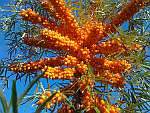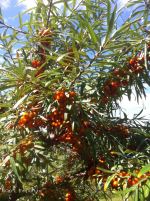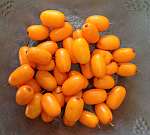
.JPG)
Harvest tool - fishline attached to end of "U"
.JPG)
Fishline slices berries off stem


Seaberry Products
Omega Fruit
Sibu
|
 |
| |
|
Seaberry / Sea Buckthorn Plants
|
|
Sea berry, Hippophae rhamnoides, are either male or female so males are needed for pollination. Males need to be planted at a rate of 1 male for every 6 females, six feet apart. Sea Berry is wind pollinated and bears approximately 3 years after planting. Sea berry is hardy to minus 40 F, grows in USDA zones 3-9 (but best in 3-7), likes full sun and well-drained soil. Ideal pH is between 6.3 and 6.8 but tolerates 5.5 - 8.5. Height 8-12'. Spread 5+'
The vitamin C concentration of sea berry fruit is 30 times higher than the amount of an orange, 25 times that of a strawberry, and 5 times that of a kiwi. Their vitamin E content exceeds wheat, corn and soybeans. Many people prefer seaberry juice to orange juice, and some enjoy eating the berries fresh off the tree. Read about more health benefits at Livestrong and 101healthyrecipes.com.
If you don't mind sugar, check out the Russian jam recipe at the end of this article. The Russian word for seaberry is oblepikha.
Orange September from Canada produces yellowish orange berries that ripen in September. Has moderately thorny branches and silvery green foliage. 8'x6'
Sunny™ Seaberry (female) is a medium height shrub (10-12') with very few thorns. It is an early ripening cultivar which has been growing in North America since the early 2000's. It starts to ripen in August in zone 3 (approx. 100 days after flowering) and harvest time runs for two weeks. It is vigorous and well adapted for our climate. The fruits are a bright yellow. Its flavor is mildly tart with a distinct mango-ish flavor. The genetics of this cultivar have been considered the best choice for home gardeners and commercial comestible crops alike for generations. The size and flavour of its fruit is among the best for cooking and juice blends. It has lower oil content than other varieties which some people prefer for making juice and other food products, while more oil may be preferred for cosmetics use. Sunny™ grows best in dry, cold climates like those east of the Cascade Mountains.
Sunny™ History: This Russian born breed (originally named Botaniceskaya Ljubitelskaya), was renamed and registered as Sunny™ in Latvia and was selected by Latvian agronomists as the first choice for commercial comestible sea buckthorn products.
Berry weight: avg. 1 gram (with proper care)
Thorns: Sunny ™ will have a few small thorns along the branch and at the tip but far less thorny than Leikora and Hergo. A bit more thorny than Chuskaya.
Use: Great for brewing beer and kombucha, and other juice blends.
mid May shipping
Orange Energy TM (female) Medium-early maturing German cultivar launched in 2005 and prized for its abundant crops of flavorful large bright orange berries. It grows very strongly with good side branching. Few thorns. 6-8' height. Originated from a cross Leikora x Pollmix 2. Fruits avg 5.1 g, oblong oval.
Total acidity: 3.1 to 3.6%
ascorbic acid (vitamin C): 149 - 289mg / 100 g fresh mass;
carotene: from 11.8 to 17.7 mg / 100 g fresh mass;
tocopherol (vitamin E): 18.9 mg / 100 g fresh mass;
total fat content: 4.9 to 6.3% (Reference)
Frugana, a German variety, is noted as a vigorous and productive, upright growing shrub, early ripening, bears large, bright orange-red berries. 10-12' height at maturity.
Male Seaberry
* 1 male per 5-7 of the above listed females
* best suited for early and mid season female varietes (listed above)
|
Planting Info expert advice from our propagator
- Yes, the roots can increase nitrogen levels in the soil. However, young sea buckthorn plants need a well-balanced amendment for a few years to begin growing the Frankia nodules from the bacterium in the soil they are planted in.
-
A loam to lightly sandy soil with decent amounts of organic matter to retain nutrients and a balanced pH is best for starting sea buckthorn shrubs off on the right foot and keeping them growing well for years.
- Soak roots in water for about 2 hrs before planting
- Dig holes large enough to fit all the roots and the rooting part of the stem: roughly 12" x 12" deep or larger
- Mix some bone meal and good compost with the soil in the hole and add the plant
- Pack the soil well around the stem.
- Water thoroughly. Continue watering every two days for two months.
- Add a good wood chip mulch as a weed barrier 3" thick x 16" D.
-
Each spring for the next three years, you can pull back the wood chips, add a compost top dressing, and return & add the wood chips over the top to maintain a cover of 3" thickness. The nutrients will leach through over time. Compact any freshly laid mulch down in a funnel shape around the trunk of the sea buckthorn plant to provide air to the base. This will help avoid excess moisture from forming there. Thus, reducing the migration of fungal growth while directing water to the center of the root system below.
Once the Sea buckthorn shrubs have reached a mature height, mulch is no longer necessary, but adding a shovel full of compost each spring will keep your shrubs looking healthy and vital.
Growing Info
Regular deep watering during the hot dry spells of summer will increase seaberry yields substantially. Phosphorus and Potash, along with micro nutrients are necessary, while Nitrogen can actually hinder the plants growth and general vigour.
Please note that some varieties of seaberry sucker, up to 15 feet or more, so should not be planted next to your neighbor's property line! Suckers are best controlled by simply mowing the grass around the bush. However, sea buckthorn should not be confused with the black-berried common buckthorn Rhamnus cathartica L. which is considered a noxious weed.
Maintain reasonable control over the sucker plants by cutting out horizontal rhizomes beneath the turf’s surface or mowing around the shrub’s base.
Keep a watchful eye on the young plant the first year it is put in the ground; it will be vulnerable to drought, weed overgrowth, ice & heavy snow, rodents and deer chewing at the young bark and branches…Also lawnmowers!
Rejuvenation: The rejuvenation cut back should happen around the 7th or 8th year. Sometime before spring break, cut back the entire plant to roughly 10-12" above the natural crown of the primary branches (the shrub will end up at roughly 3-4' H). All small branches should be cut to leave only primary trunks large enough to support regrowth. It is important to note that only healthy and well cared for trees will continuously regrow.
Seaberry needs *Full Sun*
For more info, see MISA Intro and Growing Guide from Quebec
Seaberry Links
How to Grow Sea Buckthorn 2021 Susan Pozner interviewing researcher Bill Schroder
2015 Research Gate Saskatchewan varieties
Introduction Ontario, Canada
Irrigation Report Quebec (French) 2016-2017
Frozen seaberries at The Honeyberry Farm
Universite Laval
Quebec 2013 Martin Trepanier, Ph.D., agr
Sea Buckthorn Insider
Production Guide (Thomas & McLoughlin, 1997), yukonag.ca
Lilianausvat blog 2013 - overview
Houzz forum
International Sea Buckthorn conference, Germany 2013, sanddorn.net
Harvesting technologies for sea buckthorn fruit, sciencedirect.com
Honeyberry USA Fotos of various unnamed bushes.
Proceedings of the 3rd European Workshop, Finland 2014
Growing Sea Buckthorn 102 Omega Fruit
Sexing Male/Female seaberries
More links
|
[ First ]
[ Prev ]
[ Next ]
[ Last ]
|
 |